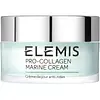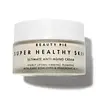What's inside
What's inside
 Key Ingredients
Key Ingredients

 Benefits
Benefits

 Concerns
Concerns

 Ingredients Side-by-side
Ingredients Side-by-side

Water
Skin ConditioningGlycerin
HumectantCaprylic/Capric Triglyceride
MaskingGlyceryl Stearate Se
EmulsifyingIsononyl Isononanoate
EmollientDicaprylyl Carbonate
EmollientDimethicone
EmollientTriticum Vulgare Germ Oil
EmollientButyrospermum Parkii Butter
Skin ConditioningChlorella Vulgaris Extract
Skin ConditioningPadina Pavonica Thallus Extract
Skin ConditioningDaucus Carota Sativa Root Extract
Skin ConditioningPorphyridium Cruentum Extract
Skin ConditioningAcacia Decurrens Flower Extract
MaskingRosa Centifolia Flower Extract
AstringentGinkgo Biloba Leaf Extract
Skin ConditioningTocopherol
AntioxidantPhenoxyethanol
PreservativePolyacrylate-13
Stearic Acid
CleansingTocopheryl Acetate
AntioxidantCoco-Caprylate/Caprate
EmollientCetyl Alcohol
EmollientXanthan Gum
EmulsifyingGlyceryl Polyacrylate
Polyisobutene
Parfum
MaskingCitric Acid
BufferingChlorphenesin
AntimicrobialGlyceryl Acrylate/Acrylic Acid Copolymer
HumectantSodium Dehydroacetate
PreservativeDisodium EDTA
Polysorbate 20
EmulsifyingSorbitan Isostearate
EmulsifyingHydroxyisohexyl 3-Cyclohexene Carboxaldehyde
MaskingButylphenyl Methylpropional
PerfumingLinalool
PerfumingCitronellol
PerfumingPotassium Sorbate
PreservativeSodium Benzoate
MaskingCitrus Limon Peel Oil
MaskingCuminum Cyminum Seed Oil
MaskingCedrus Atlantica Bark Oil
MaskingLimonene
PerfumingWater, Glycerin, Caprylic/Capric Triglyceride, Glyceryl Stearate Se, Isononyl Isononanoate, Dicaprylyl Carbonate, Dimethicone, Triticum Vulgare Germ Oil, Butyrospermum Parkii Butter, Chlorella Vulgaris Extract, Padina Pavonica Thallus Extract, Daucus Carota Sativa Root Extract, Porphyridium Cruentum Extract, Acacia Decurrens Flower Extract, Rosa Centifolia Flower Extract, Ginkgo Biloba Leaf Extract, Tocopherol, Phenoxyethanol, Polyacrylate-13, Stearic Acid, Tocopheryl Acetate, Coco-Caprylate/Caprate, Cetyl Alcohol, Xanthan Gum, Glyceryl Polyacrylate, Polyisobutene, Parfum, Citric Acid, Chlorphenesin, Glyceryl Acrylate/Acrylic Acid Copolymer, Sodium Dehydroacetate, Disodium EDTA, Polysorbate 20, Sorbitan Isostearate, Hydroxyisohexyl 3-Cyclohexene Carboxaldehyde, Butylphenyl Methylpropional, Linalool, Citronellol, Potassium Sorbate, Sodium Benzoate, Citrus Limon Peel Oil, Cuminum Cyminum Seed Oil, Cedrus Atlantica Bark Oil, Limonene
Water
Skin ConditioningCaprylic/Capric Triglyceride
MaskingGlycerin
HumectantCoco-Caprylate/Caprate
EmollientButylene Glycol
HumectantEthylhexyl Palmitate
EmollientArachidyl Alcohol
EmollientGlyceryl Stearate
EmollientPEG-100 Stearate
Dimethicone
EmollientBehenyl Alcohol
EmollientPhenoxyethanol
PreservativeCarbomer
Emulsion StabilisingPropanediol
SolventOryza Sativa Hull Powder
AbrasiveArachidyl Glucoside
EmulsifyingTocopheryl Acetate
AntioxidantChlorphenesin
AntimicrobialMica
Cosmetic ColorantCI 77891
Cosmetic ColorantAvena Sativa Kernel Extract
AbrasiveSodium Hydroxide
BufferingVp/Va Copolymer
Hydrolyzed Hyaluronic Acid
HumectantSodium Hyaluronate
HumectantParfum
MaskingO-Cymen-5-Ol
AntimicrobialAsparagus Officinalis Stem Extract
Skin ConditioningTetrasodium Glutamate Diacetate
Isomalt
HumectantLeontopodium Alpinum Flower/Leaf Extract
Skin ConditioningAlgae Extract
EmollientSodium Benzoate
MaskingHydrolyzed Beta-Glucan
Skin ConditioningAlteromonas Ferment Extract
Skin ConditioningPhenethyl Alcohol
MaskingPotassium Sorbate
PreservativeLimonene
PerfumingBuddleja Davidii Leaf Extract
Skin ConditioningThymus Vulgaris Flower/Leaf Extract
MaskingDiacetyl Boldine
Skin ConditioningCalcium Gluconate
HumectantGluconolactone
Skin ConditioningRhododendron Ferrugineum Extract
MaskingNarcissus Tazetta Bulb Extract
AstringentCitric Acid
BufferingLinalool
PerfumingLecithin
EmollientVitis Vinifera Fruit Cell Extract
Skin ConditioningDisodium Phosphate
BufferingWater, Caprylic/Capric Triglyceride, Glycerin, Coco-Caprylate/Caprate, Butylene Glycol, Ethylhexyl Palmitate, Arachidyl Alcohol, Glyceryl Stearate, PEG-100 Stearate, Dimethicone, Behenyl Alcohol, Phenoxyethanol, Carbomer, Propanediol, Oryza Sativa Hull Powder, Arachidyl Glucoside, Tocopheryl Acetate, Chlorphenesin, Mica, CI 77891, Avena Sativa Kernel Extract, Sodium Hydroxide, Vp/Va Copolymer, Hydrolyzed Hyaluronic Acid, Sodium Hyaluronate, Parfum, O-Cymen-5-Ol, Asparagus Officinalis Stem Extract, Tetrasodium Glutamate Diacetate, Isomalt, Leontopodium Alpinum Flower/Leaf Extract, Algae Extract, Sodium Benzoate, Hydrolyzed Beta-Glucan, Alteromonas Ferment Extract, Phenethyl Alcohol, Potassium Sorbate, Limonene, Buddleja Davidii Leaf Extract, Thymus Vulgaris Flower/Leaf Extract, Diacetyl Boldine, Calcium Gluconate, Gluconolactone, Rhododendron Ferrugineum Extract, Narcissus Tazetta Bulb Extract, Citric Acid, Linalool, Lecithin, Vitis Vinifera Fruit Cell Extract, Disodium Phosphate
 Reviews
Reviews

Ingredients Explained
These ingredients are found in both products.
Ingredients higher up in an ingredient list are typically present in a larger amount.
This ingredient is an emollient, solvent, and texture enhancer. It is considered a skin-softener by helping the skin prevent moisture loss.
It helps thicken a product's formula and makes it easier to spread by dissolving clumping compounds.
Caprylic Triglyceride is made by combining glycerin with coconut oil, forming a clear liquid.
While there is an assumption Caprylic Triglyceride can clog pores due to it being derived from coconut oil, there is no research supporting this.
Learn more about Caprylic/Capric TriglycerideChlorphenesin is a synthetic preservative. It helps protect a product against bacteria in order to extend shelf life. In most cases, Chlorphenesin is paired with other preservatives such as phenoxyethanol and caprylyl glycol.
Chlorphenesin is a biocide. This means it is able to help fight the microorganisms on our skin. It is also able to fight odor-releasing bacteria.
Chlorphenesin is soluble in both water and glycerin.
Studies show Chlorphenesin is easily absorbed by our skin. You should speak with a skincare professional if you have concerns about using Chlorphenesin.
Learn more about ChlorphenesinCitric Acid is an alpha hydroxy acid (AHA) naturally found in citrus fruits like oranges, lemons, and limes.
Like other AHAs, citric acid can exfoliate skin by breaking down the bonds that hold dead skin cells together. This helps reveal smoother and brighter skin underneath.
However, this exfoliating effect only happens at high concentrations (20%) which can be hard to find in cosmetic products.
Due to this, citric acid is usually included in small amounts as a pH adjuster. This helps keep products slightly more acidic and compatible with skin's natural pH.
In skincare formulas, citric acid can:
While it can provide some skin benefits, research shows lactic acid and glycolic acid are generally more effective and less irritating exfoliants.
Most citric acid used in skincare today is made by fermenting sugars (usually from molasses). This synthetic version is identical to the natural citrus form but easier to stabilize and use in formulations.
Read more about some other popular AHA's here:
Learn more about Citric AcidCoco-Caprylate/Caprate is created from fatty coconut alcohol, caprylic acid, and capric acid.
It is a lightweight emollient. Emollients create a thin barrier on the skin to trap moisture in. This helps keep your skin hydrated and soft.
Once applied, Coco-Caprylate/Caprate is absorbed quickly and leaves a silky feel.
Coco-Caprylate/Caprate may not be fungal acne safe.
Learn more about Coco-Caprylate/CaprateDimethicone is a type of synthetic silicone created from natural materials such as quartz.
What it does:
Dimethicone comes in different viscosities:
Depending on the viscosity, dimethicone has different properties.
Ingredients lists don't always show which type is used, so we recommend reaching out to the brand if you have questions about the viscosity.
This ingredient is unlikely to cause irritation because it does not get absorbed into skin. However, people with silicone allergies should be careful about using this ingredient.
Note: Dimethicone may contribute to pilling. This is because it is not oil or water soluble, so pilling may occur when layered with products. When mixed with heavy oils in a formula, the outcome is also quite greasy.
Learn more about DimethiconeGlycerin is already naturally found in your skin. It helps moisturize and protect your skin.
A study from 2016 found glycerin to be more effective as a humectant than AHAs and hyaluronic acid.
As a humectant, it helps the skin stay hydrated by pulling moisture to your skin. The low molecular weight of glycerin allows it to pull moisture into the deeper layers of your skin.
Hydrated skin improves your skin barrier; Your skin barrier helps protect against irritants and bacteria.
Glycerin has also been found to have antimicrobial and antiviral properties. Due to these properties, glycerin is often used in wound and burn treatments.
In cosmetics, glycerin is usually derived from plants such as soybean or palm. However, it can also be sourced from animals, such as tallow or animal fat.
This ingredient is organic, colorless, odorless, and non-toxic.
Glycerin is the name for this ingredient in American English. British English uses Glycerol/Glycerine.
Learn more about GlycerinLimonene is a fragrance that adds scent and taste to a formulation.
It's found in the peel oil of citrus fruits and other plants such as lavender and eucalyptus. The scent of limonene is generally described as "sweet citrus".
Limonene acts as an antioxidant, meaning it helps neutralize free radicals.
When exposed to air, oxidized limonene may sensitize the skin. Because of this, limonene is often avoided by people with sensitive skin.
The term 'fragrance' is not regulated in many countries. In many cases, it is up to the brand to define this term. For instance, many brands choose to label themselves as "fragrance-free" because they are not using synthetic fragrances. However, their products may still contain ingredients such as essential oils that are considered a fragrance.
Learn more about LimoneneLinalool is a fragrance and helps add scent to products. It's derived from common plants such as cinnamon, mint, citrus, and lavender.
Like Limonene, this ingredient oxidizes when exposed to air. Oxidized linalool can cause allergies and skin sensitivity.
This ingredient has a scent that is floral, spicy tropical, and citrus-like.
Learn more about LinaloolParfum is a catch-all term for an ingredient or more that is used to give a scent to products.
Also called "fragrance", this ingredient can be a blend of hundreds of chemicals or plant oils. This means every product with "fragrance" or "parfum" in the ingredients list is a different mixture.
For instance, Habanolide is a proprietary trade name for a specific aroma chemical. When used as a fragrance ingredient in cosmetics, most aroma chemicals fall under the broad labeling category of “FRAGRANCE” or “PARFUM” according to EU and US regulations.
The term 'parfum' or 'fragrance' is not regulated in many countries. In many cases, it is up to the brand to define this term.
For instance, many brands choose to label themselves as "fragrance-free" because they are not using synthetic fragrances. However, their products may still contain ingredients such as essential oils that are considered a fragrance by INCI standards.
One example is Calendula flower extract. Calendula is an essential oil that still imparts a scent or 'fragrance'.
Depending on the blend, the ingredients in the mixture can cause allergies and sensitivities on the skin. Some ingredients that are known EU allergens include linalool and citronellol.
Parfum can also be used to mask or cover an unpleasant scent.
The bottom line is: not all fragrances/parfum/ingredients are created equally. If you are worried about fragrances, we recommend taking a closer look at an ingredient. And of course, we always recommend speaking with a professional.
Learn more about ParfumPhenoxyethanol is a preservative that has germicide, antimicrobial, and aromatic properties. Studies show that phenoxyethanol can prevent microbial growth. By itself, it has a scent that is similar to that of a rose.
It's often used in formulations along with Caprylyl Glycol to preserve the shelf life of products.
Potassium Sorbate is a preservative used to prevent yeast and mold in products. It is commonly found in both cosmetic and food products.
This ingredient comes from potassium salt derived from sorbic acid. Sorbic acid is a natural antibiotic and effective against fungus.
Both potassium sorbate and sorbic acid can be found in baked goods, cheeses, dried meats, dried fruit, ice cream, pickles, wine, yogurt, and more.
You'll often find this ingredient used with other preservatives.
Learn more about Potassium SorbateSodium Benzoate is a preservative. It's used in both cosmetic and food products to inhibit the growth of mold and bacteria. It is typically produced synthetically.
Both the US FDA and EU Health Committee have approved the use of sodium benzoate. In the US, levels of 0.1% (of the total product) are allowed.
Sodium benzoate works as a preservative by inhibiting the growth of bacteria inside of cells. It prevents the cell from fermenting a type of sugar using an enzyme called phosphofructokinase.
It is the salt of benzoic acid. Foods containing sodium benzoate include soda, salad dressings, condiments, fruit juices, wines, and snack foods.
Studies for using ascorbic acid and sodium benzoate in cosmetics are lacking, especially in skincare routines with multiple steps.
We always recommend speaking with a professional, such as a dermatologist, if you have any concerns.
Learn more about Sodium BenzoateTocopheryl Acetate is AKA Vitamin E. It is an antioxidant and protects your skin from free radicals. Free radicals damage the skin by breaking down collagen.
One study found using Tocopheryl Acetate with Vitamin C decreased the number of sunburned cells.
Tocopheryl Acetate is commonly found in both skincare and dietary supplements.
Learn more about Tocopheryl AcetateWater. It's the most common cosmetic ingredient of all. You'll usually see it at the top of ingredient lists, meaning that it makes up the largest part of the product.
So why is it so popular? Water most often acts as a solvent - this means that it helps dissolve other ingredients into the formulation.
You'll also recognize water as that liquid we all need to stay alive. If you see this, drink a glass of water. Stay hydrated!
Learn more about Water